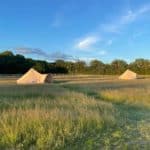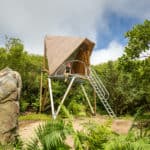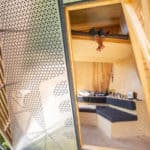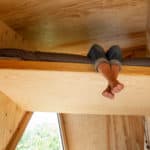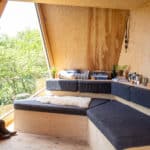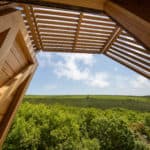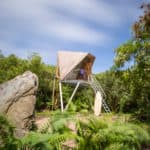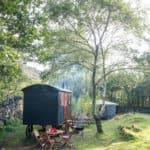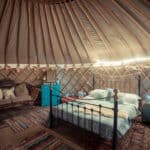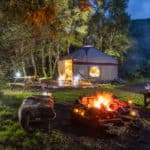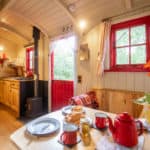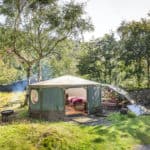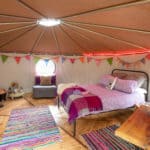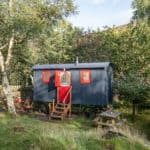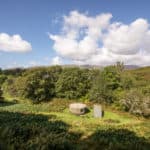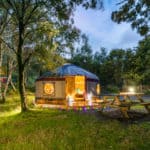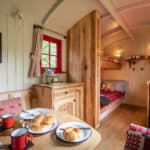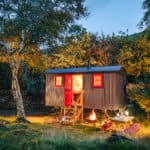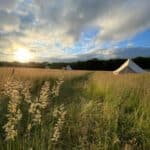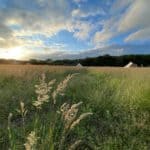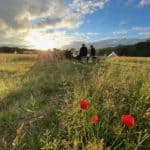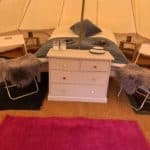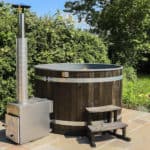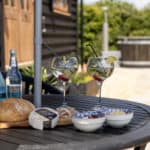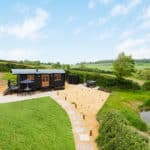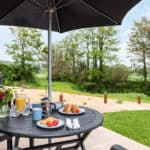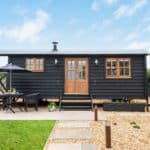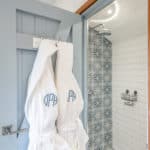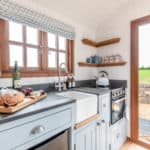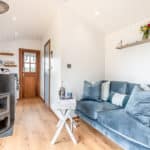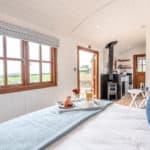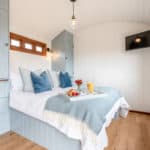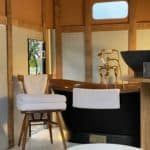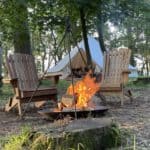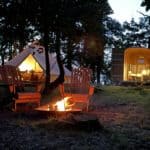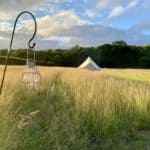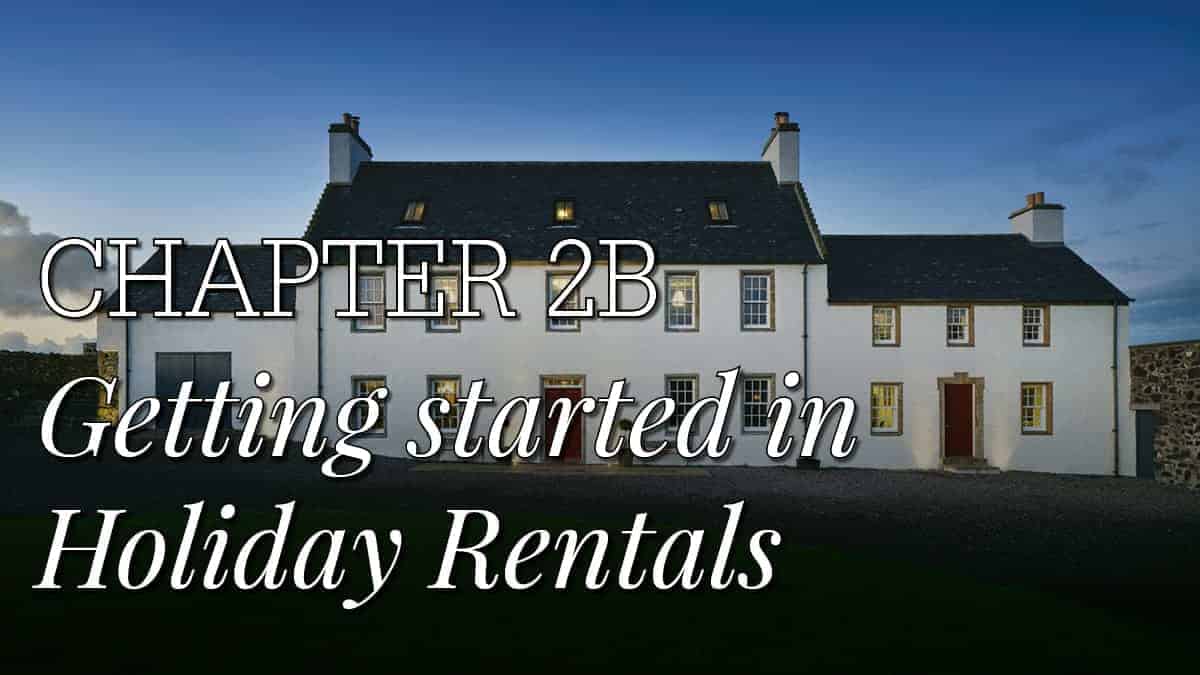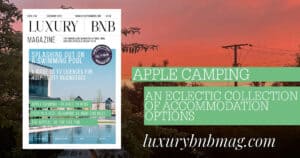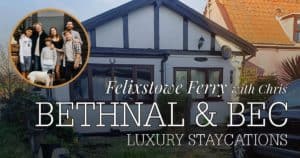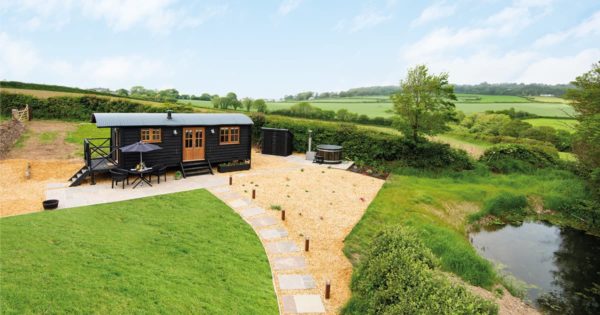
All you need to know about setting up a glamping business. Discover the different types of glamping, what to look for in a location, planning implications, business plans and more…
The word ‘glamping’ brings some luxurious and colourful images to mind.
Cosy shepherd huts and bell tents.
Rustic wooden lodges and treehouses.
Hot tubs and prosecco.
All the joys of camping without the hassle!
So why wouldn’t you want to get in on this hugely popular sector of hospitality? Especially now that staycations are on the rise.
According to Statista, online searches for ‘glamping holidays uk’ rose by 404% between July 2019 and July 2020.
Are you brand new to the hospitality sector and unsure of where to start? Or are you looking to expand your already existing glamping business?
Or maybe you’re trying something new, leaving the B&B behind and chasing your countryside business dream?
Whatever it is, we’ve got you covered.
This handy guide on how to set up a glamping business will give you an idea of where to start. We’ll provide information on the basics such as choosing a location, type of glamping, elements of a business plan and more.
To help you, we caught up with Sarah Riley, an expert on all things Glamping, to help you understand the basics. Sarah is well known in the world of glamping and unique holiday rentals. She’s a knowledgeable business coach and runs two sites that you may find helpful: inspiredcamping.com and inspiredcoursesvip.com
We also spoke with the owners of two very different glamping businesses that were set up during the pandemic.
Janice Kitto owns Daisy Park Shepherds Huts. Janice welcomed her first guests at the end of June 2021 and by October, she had gained her Superhost badge on Airbnb.
Claire Passos runs Caracol Camping near Tunbridge Wells and began the planning process for her business in 2020. Claire’s glamping business consists of bell tents, located on a local farm.
So the question is, why set up a glamping business?
Like with all new business ventures, you need to understand the industry and the direction it’s moving in. Before glamping evolved to what it is now, there was once a time when a canvas tent in a random field was considered ‘glamping’, but times have changed.
Sarah Riley said: “Now, there are much higher expectations from guests and the industry has had to develop alongside these shifting needs.”
These higher expectations have resulted in a boom of luxury, but just because you provide a relaxing getaway for guests, it doesn’t mean it will be easy for you. It takes time, money and passion.
“I’ve been advising business owners for over a decade,” said Sarah, “and many who enter the industry are aiming to spend more time outside in nature and away from their desks.”
This unique style of hospitality takes hard work, but it allows for the ‘hybrid’ working life that has become so popular during the pandemic.
Another benefit that Sarah pointed out about the glamping industry is that it allows you to “choose the business model that delivers the most benefits for you”.
This means there is no set template for starting a glamping business; it’s up to you to choose what you want it to look like and what you want to get out of it.
So with this in mind, let’s get started on pinpointing the basics.
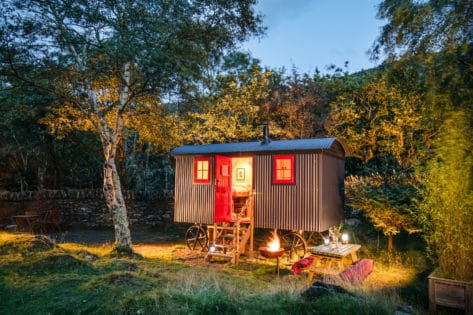
Different types of glamping
There are many different types of glamping, so how do you choose which one is right for you?
In January 2021, a forecast created by Glampitecht predicted that the most popular form of glamping for 2021 would be Shepherd Huts at 24.6%.
According to the GlampingHub Blog, the top glamping trends included treehouses, luxury tents and domes.
Although there are many different types of glamping to choose from, they each come with advantages and disadvantages.
When looking into the different structures, Sarah Riley said: “It’s important to explore the options in detail.”
For example, when deciding which structures are right for you, Sarah strongly suggests considering factors such as:
- Which structures work best for the type of land you have
- The local climate
- Seasonality
- Overhanging trees
- Storage
- Where the utilities & facilities are in relation to the structure
- Local planning restrictions
- What type of guest you hope to attract
- Lifespan of the structure
“There is a lot involved and if you are concerned about making the best decision for your business, then I would urge you to take advice,” said Sarah.
“Getting this right from the start will have a significant impact on your ongoing success.”
Janice Kitto, who runs Daisy Park Shepherds Huts, made her decision after viewing different options at a glamping show.
She said: “We looked at all the pods and the tipis but I just kept going back to the shepherd huts. I was just completely blown away by how beautiful they were inside.
“I did some research but for me, there was nothing that was on a par with the shepherd huts.
“I also felt that a lot of the options were very seasonal, like the tipis, that you can’t really let in the winter. But we were looking for something that was going to be an all year round sort of destination.”
If you’re struggling to choose what glamping structures you’d like, or you’re worried about the financial elements, there’s nothing wrong with starting small.
Claire Passos at Caracol Camping decided to start with Bell Tents.
“In an ideal world, I’d have beautiful wooden lodges that are open all year round, but that’s obviously really expensive,” said Claire.
“So we chose bell tents as a sort of starter because it’s a more cost effective way to ‘dip your toe in the water’ so to speak and it’s potentially a lot easier to get through planning.
“It just depends on your personal situation and the amount of money you have available that you can invest in the business.”
One of the potential disadvantages for glamping sites that use tents, is the longevity.
Claire said: “One of the things you have to understand is that bell tents aren’t going to look pretty forever. You may have to replace them after two or three years, which is something you’ll need to consider when looking at your business plan.”
Different structures:
- Treehouses
- Shepherd Huts
- Safari Tents
- Domes
- Bell Tents
- Glamping Pods
- Wooden Lodges
- Yurts
- Gypsy Caravans
- Tipis
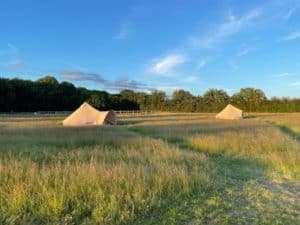
Location
We often think of rolling hills, fields, forests and nature when we think of glamping.
So how do you know where to build your site?
Of course, the type of glamping structure will impact the location and vice versa, so consider what is available to you.
Luckily, something that might make it easier for you is the fact that a glamping business can be placed anywhere.
Glamping expert, Sarah Riley said: “The land doesn’t have to be arable or of any financial value.
“I have worked with owners who have successfully started glamping businesses in old quarries or scrubland.”
But despite this, you can’t just plonk some tents in a random field. There are still factors you need to consider such as:
- Travel arrangements – Can guests get to you easily?
- Is there a view that offers a good ‘wow factor’?
- Local attractions and entertainment
- Access – is it suitable for those with disabilities?
- If you don’t own the land, do you have permission to use it?
- Noise pollution – Can you hear any roads?
If you found the perfect location for your business, but you don’t own it and it’s not up for sale, that doesn’t mean it’s not possible.
Claire Passos at Caracol Camping works in partnership with a local farmer for her business.
“We watch Countryfile every week and we saw a lot of stories about farm diversification,” said Claire.
“I then went online, found the National Farmers Union and the contact details for our region and asked if I could put a note in their local newsletter to see if anyone local was interested in diversifying their farm.
“The farmer who reached out owns a local farm shop and a 60 or so acre farm where he grows all his fruit for the shop. He’s an asparagus farmer by trade, but he approached us.”
The farmer, Michael, told Claire he had a three acre field that he was keen to diversify, helping Claire to get the ball rolling with her glamping business.
“Not everyone has three acres of land at their disposal,” said Claire, “so I think that’s really useful information if you are stuck, because there are other ways to find locations that work for you.”
Many businesses work in partnership with landowners. Sarah Riley said working with others “opens up many categories of land”.
She said: “One such business that works in partnership with various landowners around the UK is ‘crAve nature’.”
So if you don’t have land already, or the financial means to purchase land of your own, there are other options available to you.
But what qualities should you look for when choosing your site?
Janice Kitto at Daisy Park Shepherds Huts chose what she describes as a “secluded and peaceful” location.
“We’re on a farm in the country anyway, but the site we chose on the farm has a little natural pond and it’s such a lovely sight,” said Janice.
“Initially, I discounted it because it meant putting a track across the field, but I managed to persuade my husband to let us do it!
“I think it’s important to consider access,” she said.
“You go to some glamping sites and your car is parked a long way away and you’ve got a long stomp through fields to get to your accommodation.
“That’s fine on a sunny day, but in the middle of winter, in sideways rain, you want to be able to park quite close to where you’re staying.
“Putting the track across the field made that a lot easier for us.”
If you want to run a glamping business that trades all year round, it’s important to consider how the weather will affect access to your accommodation.
“It’s going to get muddy in the winter,” said Janice, “and people don’t want to carry all their stuff across a muddy field in the rain do they?”
It can be quite inconvenient if guests are not prepared, so when you are choosing your location, remember to think about how your guests will get there from their car.
Are they trekking through a forest?
Or can they park directly next to their accommodation?
But this doesn’t mean you can’t have your car parking spaces further afield.
For example, Squirrel’s Nest has three luxury treehouses located across their working farm. Guests park up and use wheelbarrows to transport their luggage across the fields to their treehouse.
However this is all part of the experience at Squirrel’s Nest and it works for their business model, so it doesn’t mean you can’t do something similar.
Claire Passos, from Caracol Camping, added that you need to explore your local area as well, before choosing your location.
“We’re really lucky because we’re in an Area of Outstanding Natural Beauty in the south-east of England,” said Claire.
“We’ve got castles, walking trails, and cycling routes all around us, so there’s a lot to offer for tourists around here.
“We’re also only an hour away from London, so there’s a lot of activities available for our guests.”
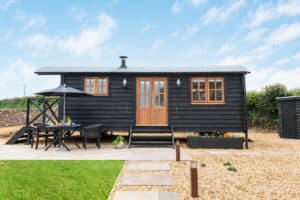
Planning
Unfortunately, it’s not always plain sailing when starting a new business venture; you’re going to have to jump through a few hoops on the way to getting your glamping site up and running.
Claire Passos submitted a pre-planning application for her glamping business, which is something you may want to consider.
“I thought doing a pre-planning application was a good idea because then you’re on the council’s books, they’ve noted what you are trying to do and then you wait for them to come back to you,” said Claire.
“It just provided a more seamless process for when I submitted the full planning application.”
Claire submitted her pre-planning application in August 2020 and heard back from her local council in December 2020.
“They came back to me and said they noted what I wanted to do and what they needed now was a number of different surveys and reports,” explained Claire.
Some of the reports Claire was asked to supply alongside her full planning application that would be submitted at a later date included:
- Ecology Survey
- Habitat Survey
- Landscape Visual Impact Assessment
- Traffic Assessment
Claire said: “It can be quite a lengthy process and you can do it yourself, or you can pay a planning consultant to do it for you.
“But you will need to work with professionals to get the ecology and habitat surveys and other reports that the council wants from you.”
She added: “It can be quite time consuming and quite expensive to get these reports, so be prepared to put the work in.”
When working on your planning application, it’s important to look beyond your immediate surroundings. It’s not just about the specific location you chose; it’s also about the wider, local area.
Claire said: “You’ve really got to delve deep into your local area. We’re in an Area of Outstanding Natural Beauty, so we needed to understand what the High Weald AONB Management Plan was.”
The High Weald is an AONB in the south-east of England which covers areas of Sussex, Kent and Surrey. Claire’s glamping business, Caracol Camping, is located in this region, so she had to look beyond the farm and the field where her tents are, to the wider, surrounding areas.
But it’s not just about understanding the land around you, it’s also about understanding the local communities.
“You should also look at the local tourism bodies and get as much information as you can about what’s happening locally and what sort of proposals there are for the future,” said Claire.
“You will also want to read the National Policy Planning Framework, which is a government initiative that every new business has to adhere to. But there’s also more localised versions of this that you need to look at.”
Claire stressed that you have to be prepared for a lot of hard work.
“You’ve got to jump through a lot of hoops and tick a lot of boxes so that the planning department is comfortable with what you’re doing,” she said.
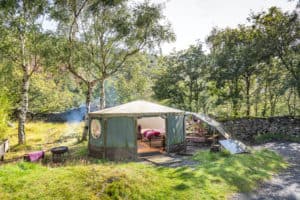
Business Plan
The main thing to keep in mind when creating a business plan, is to try and be prepared for different situations.
Glamping expert, Sarah Riley, has a lot of experience working on business plans.
She said: “Whenever I’m asked to help an owner overcome obstacles that have become barriers to the launch of their business, it’s almost always something that could have been avoided with more time spent planning at the start.”
Sarah also explained that there are two elements to a business plan. It’s not just about the data; there also needs to be a narrative.
“However, a narrative is only usually needed if there are investors involved,” said Sarah.
But if you don’t have investors, then Sarah says you should focus on elements such as:
- Set-up costs
- Income projections
- Return on investment
- Yield return period
One of the biggest mistakes Sarah sees with business plans is that owners do not focus on their finances, complaining that it’s too difficult to find the data.
“This can lead to bad decision making and bad budget keeping,” explained Sarah, “which will lead you down a path of spiralling costs, struggles and potential failure.”
But Sarah was quick to point out that this can easily be overcome by getting an expert to help you.
Don’t want to spend the money on an expert’s help? Sarah said: “The savings made by avoiding bad decision-making will more than pay for any investment you make.”
Janice Kitto at Daisy Park Shepherd Huts also pointed out that budgets can change.
“We went quite a bit over budget,” said Janice, “so it’s always a good idea to allow for a bit more.”
Janice also explained there’s a lot of different costs to consider which you may not have thought about at first.
“Obviously there’s the cost of buying the hut or the tents, but then there’s all the groundwork,” she said.
“Things like electricity, water, all the services like sewage and all that. Things you take for granted and become almost like ‘hidden costs’. So make sure you remember to include these in your plan.”
She added: “You can pretty much guarantee that it will cost more than what you originally planned.”
Although there are expenses involved with setting up your glamping business, Claire Passos suggested you try to spend as little as possible until you’ve gone through the planning process.
“You don’t want to spend a lot of money on a shepherds hut or a beautiful wooden lodge, only for the planning to come back and find out you don’t have authorisation,” said Claire.
However, for those of you who are considering temporary or collapsable structures than can be moved around, Claire suggested doing a ‘Pop-Up’.
A pop-up is almost like a ‘trial run’, which could be very useful when working on your business plan. It could also be done whilst you are waiting to hear back on your planning applications.
“So there’s this government scheme called the Permitted Development Rule,” said Claire.
“Originally, it meant that you could do almost anything without permission for 28 days, but it was then extended to 56 days.”
After Claire submitted her pre-planning application, Claire bought four bell tents so she could run a pop-up glamping site and ‘test the water’ whilst she waited to hear back from the council.
“We bought the tents to test it out for those 56 days,” said Claire.
“It helped us to understand how the tents operated and allowed us to get a feel for what it would be like running the business.
“It’s a great way to test the waters and get feedback from guests, but you do have to remember it’s only a pop-up, so of course it’s not going to be as luxurious as the main business would be.”
If you are able to run a pop-up, Claire strongly suggests running one whilst waiting to hear back on planning applications because it can help you to refine your business plan.
It can help you to:
Figure out how your structures operate
- Wear and tear
- Cleaning systems
- Maintenance
- Building the structure
- Size of the structure and how many can you fit on your site?
Work out prices and other financial questions
- How much are you going to charge guests?
- How much do individual units of your chosen structure cost?
- What is the profit margin per stay?
- Revenue forecasts based on the 56 days (taking into account improvements)
Feedback
- What did your guests like/dislike?
- Where can you improve your business plan?
- What do guests expect from your business?
- What would they pay more for?
Facilities
- Do you have the right number of facilities available? (e.g. the toilet and shower to guest ratio)
- Do you need to pay for new facilities? (e.g. another toilet block at a campsite)
Amenities
- Do you need to invest in wifi extenders?
- What other amenities may you need to invest in? (e.g. hair dryers, tvs, hot tubs)
All of the above will help you get a clearer picture of your financial situation, which in turn, will improve your business plan.
As Sarah Riley stated, a strong business plan will influence your decision making and the success of your business.
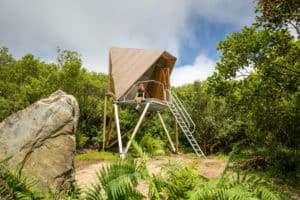
Extras, Experiences and Packages
These days, offering somewhere unique isn’t enough. You’ve got to provide more for your guests so they feel like they are getting value for their money.
One of the ways you can do this as an owner of a glamping business, is by offering extras, experiences and packages.
The easiest way to do this is to offer your guests seasonal hampers and welcome packages.
These could include things like:
A bottle of your chosen alcoholic beverage
- Do you make your own gin?
- Is there a local whisky distillery?
- Maybe a bottle of bubbly
- Drinks with local roots will go down well
Sweet treats
- Is there a local independent chocolatier?
- A local fudge maker?
- Homemade biscuits?
- Sweet treats with local roots will go down well
Flyers and leaflets
- Activity ideas
- Info on places to go out for dinner
- Takeaway menus
- Info on where the local shops are
- Walking routes
- Locations of popular viewpoints
Local products
- You could work with local businesses and use their products in your hampers or welcome packages. This will help to promote their business to you guests.
You aren’t just limited to hampers, however. You may have your own wonderful ideas on what extras you can offer your guests.
Sarah Riley said: “People love variety and ‘Instagrammable’ moments, but you must always think about the implications of offering those little extras.
“Whatever you decided to offer as extras, focus on how it helps to enhance your unique stay, and link it to your personality and your local area.”
Your extras don’t always have to be edible or disposable items. They can also relate to the facilities and amenities that are available for the guests to use.
Janice Kitto said: “Without a shadow of a doubt, I’d say get a hot tub.
“In my guest book, I think nearly every comment has included something about how the guests love the hot tub.”
She added: “I think it’s one of the most searched for criteria when people search for holidays. They are really popular.”
However, returning to Sarah’s earlier comment, it’s important to consider the implications of such things.
Sarah said: “For example, there’s no doubt that hot tubs increase occupancy, but they also come with increased costs and a lot of time added to the changeover. They also impact the local environment because of the amount of water used and the chemicals needed to keep the water safe for guests.”
There are ways you can get around this, however. Bethnal & Bec Luxury Staycations in Hertfordshire use a more environmentally friendly alternative to hot tubs.
Their three retreats all have outdoor baths, which offer the same experience as a hot tub, but on a more eco-friendly level.
Claire Passos believes extras are really important for glamping businesses, especially now that glamping is so popular.
“Everyone has jumped on this bandwagon, so what are you offering that’s different?” said Claire.
“At Caracol camping, we’re going to sow a wildflower meadow and have the tents nestled within the meadow.
“Not only does that tick a lot of boxes in terms of biodiversity and ecology, but it also creates a lovely, intimate experience for our guests because it’s as if they have their own, cosy corner in the meadow.”
Claire’s campsite is lucky enough to also have an ancient woodland backing onto the field which could be utilised for unique experiences.
“There’s lots of new initiatives like forest bathing,” said Claire, “so we can offer that to our guests, as well as corporate groups.”
She added: “I’m really keen on the whole idea of getting back to nature as a solution for improving mental health.”
When it comes to the activities that are available, Claire suggests creating bespoke experiences for your guests.
“Look at what’s around you and create packages for your guests. It just helps to widen your target market,” she said.
Some ideas might include:
- Walking Package: e.g. routes of different difficulties and length, viewpoints, historical locations
- Cycling Package: e.g routes of different difficulties and length, popular break points such as cafes and pubs
- Historic Package: e.g list of local historical sights, visitor attractions, history of the local area
- Adventurous activities: e.g. popular climbing spots, list of activity providers, popular paddleboarding routes
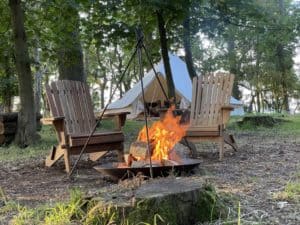
Do’s and Don’ts
DO:
- Focus on the financial breakdown of your set-up process and cash flow forecast. His will help with decision making and solvency – Sarah Riley
- Provide an excellent service and aim for amazing reviews. Just because it’s an asset-light business does not mean it can be delivered half-heartedly. – Sarah Riley
- Visit other glamping sites similar to what yours will be. If you are setting up a shepherds hut business, go and stay in some shepherd huts. Find out what you liked about that business and where they could improve so you can provide the best service at your own site. – Janice Kitto
- Get in touch with local tourism bodies, local councillors and local businesses when writing your planning application. Get as much information as you can, because this will support your application – Claire Passos
- Spend enough time considering the utilities at your site. Do you already have the means to supply electricity, water, etc, or do you need to build the infrastructure for this? Or can you tailor your business and provide these resources in other ways? – Claire Passos
DON’T
- Don’t forget to build a marketing strategy. This is how you will achieve occupancy and the income you need. – Sarah Riley
- Don’t ignore the environmental footprint of your business. It’s important to understand you will have guests who find this extremely important. It may a deal-breaker when choosing where to go on holiday – Sarah Riley
- Don’t forget to prioritise what you want to get out of setting up a glamping business. We only live once so it’s important to enjoy the ride – Sarah Riley
- Don’t try and make your site sound better than it is. Give honest descriptions and use great photographs in your marketing strategy. – Janice Kitto
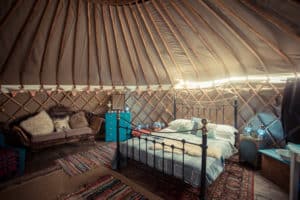
Sarah Riley’s Top Tips:
- Understand what you want to set up from the start and the level of investment needed. Pay particular attention to any permissions and utility extensions as this can have a significant impact on your overall project.
- Know who your audience is and what will appeal to them in terms of a service.
- There’s no point having an amazing site if no one knows you exist so make sure you focus on your marketing efforts as soon as possible.
- Seek out a supportive community and advice from someone with experience in a variety of glamping operations.
- Finally, be sure to prioritise what you want to get out of the project, whether this is financial or more about your lifestyle aspirations.
Top Tips from Caracol Camping:
- Understand what your USP is going to be and how you can use this to set yourself up as a successful glamping business
- Don’t underestimate the hard work. This isn’t going to happen overnight
- Test the waters with a pop-up site so you can see if you really enjoy it and what you might need to do to improve the real thing
- Visit shows and exhibitions like the Glamping Show at Stoneleigh Park
- Make the most of offering extras and different experiences. These can add value, convince guests to choose you, and also be another potential revenue stream.
Top Tips from Daisy Park Huts:
- Choose quality. For all your bedding and furnishings, try to get the best you can.
- Personal greeting. Make sure you’re there to greet guests and give them a good experience.
- Using OTAs like Airbnb is a good way to get started whilst you get your own website up and running
- Invest in some good quality, professional photos to promote your business and entice people to stay with you
- Be active on social media
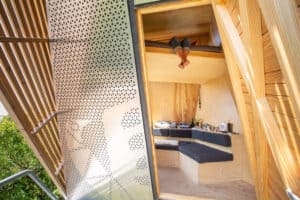
URLs
@inspired_camping
@dasiyparkhuts
@caracol_camp

